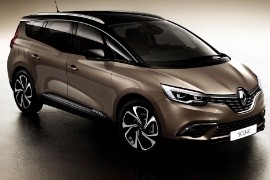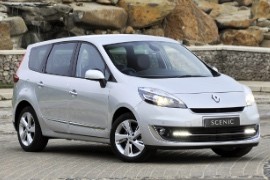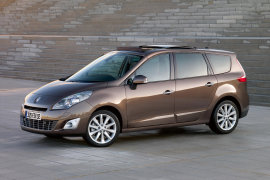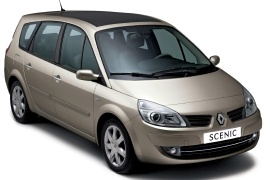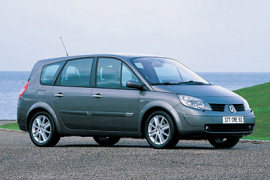RENAULT Grand Scenic Models/Series Timeline, Specifications & Photos
First production year: 2003
Engines: Gasoline, Diesel, Hybrid
Body style: Van
Renault took a gamble when it launched the first Renault Espace back in the '80s, but gain more when it expanded its MPV range, like the Renault Scenic and Grand Scenic.
In 2016, Renault launched a new generation for the Scenic and, also, a longer version for the Scenic range and named it Grand Scenic. It was an MPV that offered up to seven seats plus some trunk space. But if it was fitted with only 5 seats, the trunk volume was 718 liters (25.3 cu-ft). The extra 24 cm (9.4") wheelbase was needed to offer a roomier interior and more comfort for the rear passengers, even though most of the time those are placed safely in child seats. The Grand Scenic could have been equipped with a large panoramic glass roof with no cross-member for better light. Renault had a bold move in the segment, offering 20" light-alloy wheels fitted as standard. In the middle of the dashboard, going down on the center console, Renault offered an 8.7" tablet for the R-Link infotainment system.
The exterior had a dynamic look, with a V-shaped grille and angled headlights. It resembled the Captur range more than the Megane. But it sat on the new CMF-CD platform, used by the Renault-Nissan-Mitsubishi alliance for various vehicles, including the Nissan Rogue and the Nissan Qashqai. The Renault Grand Scenic was offered with 6 diesel engines and two gasoline units. It was available with a 6-speed manual or 7-speed automatic (dual-clutch).
In 2013 Renault upgraded the Grand Scenic lineup along with its smaller sibling, the Scenic, and added some interesting new options for the drivetrains.
Renault had dominated the MPV segment for almost two decades, and it did that by keeping its vehicles ahead of the competition. While it wasn't the best-looking nor the most potent minivan on the European market, its sales were high thanks to its safety scores and friendly interiors. For the 2013 model year, the Grand Scenic received more options that were not available on other minivans on the market.
Renault knew that a facelift had to be noticed from the outside, so it went on to create a new front fascia. Thus, the car received e redesigned lower bumper that included LED daytime running lights incorporated into the lower scoops. In addition, the bumper also incorporated an upper grille, which hosted the automaker's badge in the middle and a chromed horizontal slat. Despite having a mere 5 cm (1.96") longer wheelbase, it was 24 cm (9.44") longer due to the extended rear overhang.
Inside, the Grand Scenic featured a new screen hosted on the dashboard atop the center stack. Its R-Link infotainment system was accessible via a small joystick placed on the center console in front of the armrest. Like its predecessor, the facelifted version was available with bucket seats at the front and a split-folding bench for three in the middle. As an option, the Grand Scenic was available with three rows of seats, increasing the overall capacity to seven occupants.
But the most significant changes were performed under the car's skin. There was a new range of engines available and, most importantly, an XMOD version, which featured an electronically-controlled differential at the front, so it could tackle some mud and snow situations better than most of its competitors.
Renault lengthened the wheelbase of a Scenic, thus creating the Grand Scenic, a successful minivan that could accommodate seven and still offer decent fuel efficiency.
Strangely though, the French automaker considered launching the longer version a couple of months before the standard-wheelbase model, giving it a head-start. Thus, many customers had time to appreciate the benefits of a larger cabin, even though that came with the disadvantage of a longer vehicle that was difficult to park in crowded cities.
The car's design resembled the one of a high-speed train, with a sloped front side and a wide, raked windshield. With the headlights' shape inspired by those installed on the Megane Coupe, the carmaker tried to convince customers that this is a sportier minivan. Moreover, it even angled down the roof line to make the vehicle look more dynamic. At the back, Renault placed the taillights very high on the D-pillars, protecting them from small bumps in the parking lot.
While other European carmakers struggled to get a grip on the MPV market, Renault was dominating it. One of its advantages was the interior, which was tailored for comfort and an airy feeling. The dashboard was covered by soft material, and the instrument cluster took center stage. Thus, even those seated in the rear could read the vehicle's speed on the digital speedometer. Renault installed three rows of seats in the car on a 2-3-2 layout. The rearmost row could've been completely removed and traded for more storage space.
Under the hood, Renault installed a wide choice of engines, gasoline or diesel, most of them being turbocharged. Most of them were fitted with a six-speed manual, while a few versions were available with a six-speed automatic or a CVT.
RENAULT Grand Scenic 1.5L dCi 6AT FWD (110 HP)
RENAULT Grand Scenic 1.5L dCi 6MT FWD (105 HP)
RENAULT Grand Scenic 1.5L dCi 6MT FWD (110 HP)
RENAULT Grand Scenic 1.5L dCi Energy 6MT FWD (110 HP)
RENAULT Grand Scenic 1.6L dCi Energy 6MT FWD (130 HP)
RENAULT Grand Scenic 1.9L dCi 6MT FWD (130 HP)
Renault was the MPV sales-winner in Europe when it decided to expand its range and, apart from the Espace, it introduced the Scenic range based on the compact-segment Megane.
When it introduced the second generation of the Megane in 2002, the Scenic was already a different range. It evolved in two versions that sported a long or a short wheelbase unveiled in 2003. Three years later, the carmaker improved its lineup and brought the facelifted Scenic II.
Renault didn't improve the MPV too much. Its designers barely touched the car's look here and there for a fresh look. At the front, the carmaker installed new lens headlights. Its bumper sported shorter, body-colored rubber strips at the front instead of the long, black one available on the non-facelifted version. Its lower grille looked like a big smile, confirming the family-oriented vehicle on top of the European minivan sales. The black rubber protections against small bumps (mainly shopping carts) were replaced with body-colored ones from its sides. In the rear, Renault placed a new set of taillights with shorter, clear, reversing lights.
Inside, the carmaker made a few improvements for the driver. The steering wheel sported four buttons for the cruise control functions, while the audio controls remained stuck on a satellite stack behind the steering wheel. Like its non-facelifted version, the Grand Scenic offered room for up to seven passengers, with some trunk left behind the last row of seats for a couple of briefcases. If necessary, the second and third-row could have been folded to increase the storage area.
Under the hood, Renault offered a choice of three gasoline and three diesel engines paired as standard to a six-speed manual gearbox.
Renault introduced the second generation of the Scenic MPV in 2003 but added a longer wheelbase version, which was named Grand Scenic.
Using the same platform as the Megane lineup, the French carmaker created an affordable minivan for families. Moreover, the car was fitted with fuel-efficient engines, so they didn't cost too much to use them. Last but not least, the automaker built this seven-seat version so the entire family could get along and bring a couple of friends.
Like its predecessor, the second generation of the Scenic was egg-shaped, with a raked hood and a windshield that almost continued on the same line. In addition, a panoramic glass roof that opened was on the options list. The extended wheelbase was easy to spot from its profile, and the longer rear side window brought more light for the rearmost passengers. Finally, the carmaker added a vertical tailgate at the back that followed the same design language as the Megane Hatchback and sported corner-mounted taillights.
Inside, the Grand Scenic featured bucket seats at the front that provided comfort for the occupants and excellent visibility of the road and the surroundings. Moreover, the instrument cluster took center stage on the dashboard, with an oversized display for the speedometer and tachometer. Thus, even those sitting in the middle row could read the speedometer. Thanks to the extended wheelbase, the car could accommodate two more people on jump seats in the trunk area. These could have been folded down or removed to create a larger trunk area.
Under the hood, Renault installed a choice of gasoline and turbo-diesel engines paired either with a manual or an automatic transmission, depending on the version.
